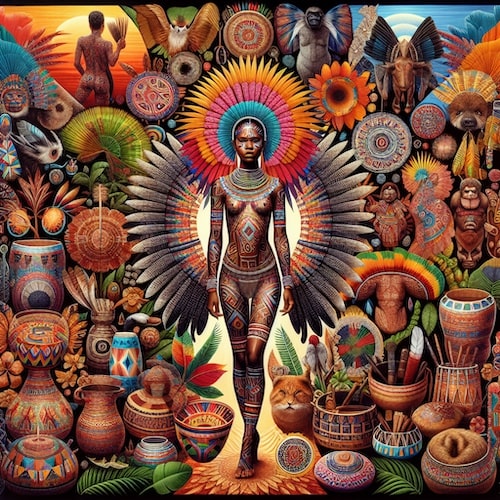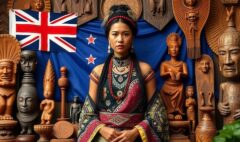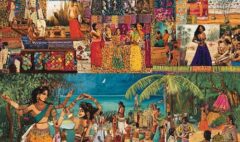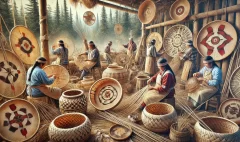Discovering the Indigenous Arts of Brazil
Brazil is a country rich in biodiversity and cultural diversity, home to many indigenous groups with ancient roots in the region. These communities have developed Indigenous Arts of Brazil as a unique artistic traditions that offer a glimpse into their history, beliefs, and connection to the natural world. Brazil’s indigenous art is a vibrant expression of their identities, passed down through generations and continuously evolving.
The Significance of Indigenous Art
Indigenous art in Brazil holds much more than aesthetic value; it is a means of storytelling, a repository of cultural memory, and an integral part of spiritual life. Brazil indigenous art encompasses a broad spectrum of forms, from body painting and featherwork to weaving and music. Each art form serves specific roles within the community and reflects the environment and lifestyle of the people who create them.Body Painting and Tattoos
One of the most striking forms of Brazil indigenous art is body painting. Indigenous groups such as the Kayapo and Yanomami use natural pigments made from clay, seeds, and plants to adorn their bodies with intricate designs. These patterns are not merely decorative; they are deep markers of identity, indicating social status, personal achievements, and religious beliefs. The designs often draw inspiration from the natural world, featuring animal motifs and geometric patterns that have symbolic meanings. Tattoos serve a similar purpose, offering a permanent way to carry cultural symbols and personal stories.Weaving and Basketry
Weaving is a central part of life in many indigenous communities in Brazil. Women, who have historically been the primary creators of these crafts, produce intricate textiles and baskets from natural fibers such as cotton, palm leaves, and bark. The process involves great skill and creativity, with each piece telling a story through its colors and patterns. Brazil indigenous art in the form of weaving not only highlights the technical prowess of its creators but also reflects their relationship with the environment. These items are both functional and beautiful, used in everyday life and significant ceremonies.Ceramics
Ceramic art is another prominent expression of Brazil indigenous art. Pottery is crafted using traditional methods, with artists shaping the clay by hand and firing it in open pits or rudimentary kilns. The designs on these ceramic pieces often incorporate intricate patterns and can vary significantly between different tribes. For instance, the Marajoara people create pottery with bold, geometric motifs, while the Bororo are known for their colorful and playful designs. These ceramics serve practical functions but are also used in rituals, highlighting their cultural significance.Featherwork
Featherwork is a distinctive and esteemed art form among Brazilian indigenous groups. Communities such as the Tucano and Karajá create stunning headdresses, masks, and ornaments using the feathers of birds like macaws and toucans. This art form requires not only artistic talent but also a deep understanding of the birds’ behaviors and habitats. In Brazil indigenous art, featherwork signifies beauty, power, and the connection to the spiritual realm. These vibrant pieces are often worn during ceremonies and dances, symbolizing the wearers’ roles as intermediaries between the material and spiritual worlds.Music and Dance
Music and dance form the heartbeat of Brazil indigenous art, used to tell stories, celebrate ancestors, and engage with spiritual beliefs. Traditional instruments, such as flutes, drums, and rattles, are crafted from natural materials. Each instrument has a unique sound that contributes to the rich tapestry of indigenous music. Dances are performed during rituals, social gatherings, and celebrations, serving as a form of expression that transcends language. Through music and dance, indigenous communities maintain their oral histories and cultural identities.Preserving Indigenous Art
Today, Brazil indigenous art faces challenges from external pressures such as deforestation, industrialization, and cultural homogenization. Many indigenous artists are striving to preserve their traditions while also seeking new platforms for expression. Efforts to promote these arts are essential for sustaining their cultural heritage. Festivals, exhibitions, and collaborations with international artists help raise awareness of the richness and diversity of indigenous art.Conclusion
The indigenous arts of Brazil offer a window into the soul of the country’s original inhabitants. Through body painting, weaving, ceramics, featherwork, and music, these communities express their relationship with the land, their ancestors, and their spiritual beliefs. By embracing and supporting Brazil indigenous art, we acknowledge and celebrate the invaluable contributions these artists make to the world’s cultural heritage. Engaging with these art forms allows us to understand the uniqueness of each indigenous group and appreciate the shared human experience of artistic expression. Whether through the intricate lines of a body painting or the rhythmic beat of a drum, Brazil’s indigenous art speaks of resilience, creativity, and a profound connection to the natural world. These artistic traditions remind us of the diversity and richness that indigenous communities bring to our global society, inviting us to see the world through their eyes.Related Posts
The Meditative Power of Ikebana: Finding Calm Through Flower Arranging
October 29, 2024
176 views
The Captivating World of New Zealand Indigenous Arts
October 23, 2024
202 views
Exploring the Indigenous Arts of India
October 9, 2024
170 views
Discovering the Indigenous Arts of Russia
October 7, 2024
181 views
Weaving Wonders: The Beautiful Art of Indigenous Basket Making in Canada
August 10, 2024
161 views
Search
Latest Posts
Popular Tags











